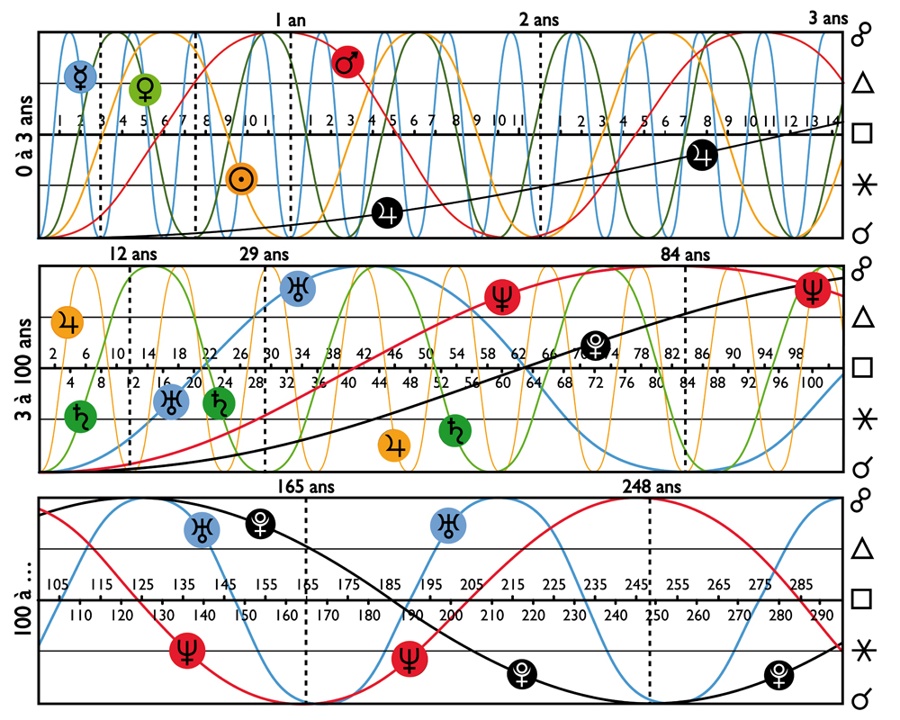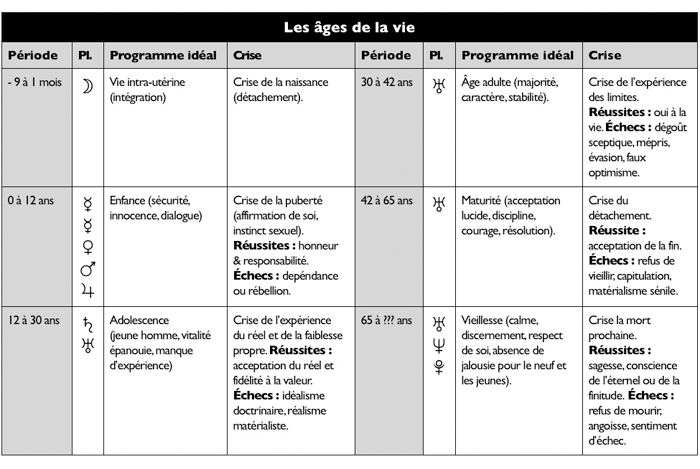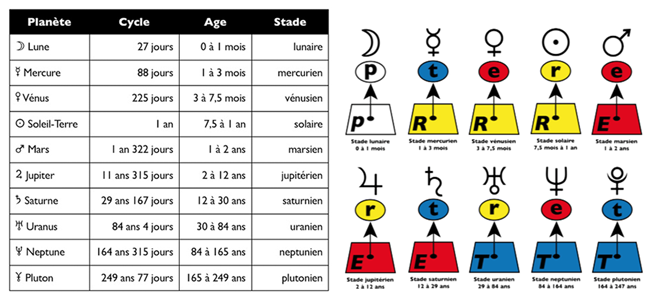Your Planets
Portraits of the Planets
Aspects between Planets
The planetary ages
The planetary families
Planets in Signs
The Planets in comics


There is a way to study and understand, on the fly, the planetary meanings. Each celestial body in the solar system has its characteristic period of sidereal revolution (from around 27 days for the Moon, Earth’s satellite, to around 248 years for Pluto, the most eccentric of the planets). The development of these cycles and intercycles (time) induces variations in structure (model R.E.T.) periodically within the system. How could men, inhabitants of the Earth, an integral part of this spatio-temporal organization, not be sensitive to these rhythms, durations, cycles and periods?
Man has therefore integrated the durations of sidereal revolution, which correspond to stages of development, which amounts to applying sidereal cycles to psychogenetics: “The theory of ages designates this application which consists quite simply in observing what mental, psychological, physiological, relational acquisitions occur in a normal evolution of man in the succession of time intervals given by the durations of sidereal revolutions… planetary meanings are studied on the spot, in the apprenticeships and acquisitions of each age of life placed in parallel with the strongest cycle at the age concerned.” Example: to study live the meanings of the Moon, we will look at the period from 0 to 27 days, duration of a lunar cycle, and it is the duration between 27 days and 88 days (duration of a Mercurian cycle) to which we will refer to understand the meanings attributed to Mercury.

Let us observe the journey of a human being, from birth to death.
It first comes out of its mother’s womb. He is a dependent baby, who will gradually open up to the world around him, first curious, then moved, then interested in the spectacle he offers him and the adults he learns to imitate. Around the age of one, he acquires his locomotor independence: he then experiences live beings, things and situations. Around the age of two, he begins to learn the language and the laws, codes and models that regulate life in society. Around twelve years old, he leaves the world of childhood for that of adolescence: puberty, melancholy, doubts, abstractions or revolts. Around thirty, he is supposed to have become an autonomous, individualized and responsible adult, fully mastering his affectivity. At the end of his life, he will turn into an old man confronted with the anguish of dying, the ultimate learning experience, and haunted by the unknown of death. Its life cycle completed, it will die. The matter of which he is made will decay and reenter the bio-chemical cycles of the Earth and the human community will continue without him. As for his soul, who knows? In any case, unless he powerfully marked his time with exemplary benefits or misdeeds, his brief trajectory will quickly be diluted in the nothingness of oblivion. The durations of the planetary cycles punctuate and structure this journey, from birth to death: “We are in the presence of a universal repetition. All the possible horoscopes of prehistory suffered from this law. Assuming that Man is the result of a natural logic (evolution and mutation), the human species was built with the impregnation of these celestial rhythms.”
The table below, which summarizes this initiatory journey, was produced from the text of Mr. Guardini, ages of life, ed. du Cerf 1957, with the exception of references to planets, indicated durations and the last box).

The human being is constructed: he is the object of a “succession of transformations, that is to say of an evolution which takes place at a determined speed: the crossing of each stage must occur at a certain rhythm and it is on this condition that there is an opening other stages and not stagnation.”
The crossing of each of these stages is carried out in synchronization with the durations of sidereal revolution of the planets, and each of these stages sees the appearance of a new psychological function: this is why astrology speaks on this subject of planetary functions.
The times of sidereal revolution or cycles (geocentric for the Earth satellite Moon, heliocentric for the planets) are as follows:

Of course, the heliocentric cycle of the Earth (1 year) corresponds, in geocentric design, to that of the Sun. Note also that the Sun and the Moon are not planets, but a star and a satellite. Astrology nevertheless designates under the general term “planet” all the stars of the solar system.
It only remains to establish the parallel between planetary durations and the stages of human development. For simplicity, cycle lengths have been rounded to: 1 month (Moon), 3 months (Mercury), 7.5 months (Venus), 1 year (Sun), 2 years (Mars), 12 years (Jupiter), 29 years old (Saturn), 84 years old (Uranus), 165 years old (Neptune) and 248 years old (Pluto).
Important: the data concerning the evolution of physical, logical and mathematical notions during childhood (Jupiterian stage from 2 to 12 years old) and adolescence (Saturnian stage from 12 to 30 years old) are based on the work of psychogeneticists (in particular those of Jean Piaget) which were known to the author at the time of writing (about 1980–1990). As I write these lines (end of 2019), knowledge in this area has evolved a lot. For example, you can follow recent progress by reading Child psychology, forty years after Piaget by Olivier Houde. I quote you two very significant extracts, accompanied by my comments:
“The conception of the development of the child’s intelligence according to Jean Piaget was linear and cumulative because it was systematically linked, stage after stage, to the idea of acquisition and progress. This is what can be called ‘the model of the staircase’, each step corresponding to a great progress, to a well-defined stage in the genesis of so-called ‘logico-mathematical’ intelligence: from intelligence sensory-motor of the baby (0–2 years), based on his senses and his actions, to the conceptual and abstract intelligence of the child (2–12 years), of the teenager and of the adult. On the one hand, babies already have fairly complex cognitive capacities, that is to say physical, mathematical, logical and psychological knowledge ignored by J. Piaget and not reducible to strictly sensory-motor functioning (the first step of the stairs).” Comment: it has been demonstrated experimentally, by means that Piaget could not have had at his disposal, that the baby, during the lunar, mercurian, venusian, solar and marsian stages had cognitive abilities much more complex than those described in the texts that follow.
“On the other hand, the continuation of the development of intelligence up to adolescence and adulthood included (the last step) is punctuated with errors, perceptual biases, unexpected shifts, not predicted by the theory piagetian. Thus, rather than following a line or a plane that leads from the sensory-motor to the abstract (the stages of J. Piaget), intelligence advances in a rather quirky, non-linear way.” Comment: these discoveries which seriously disturb the linear hyper-rationalism of Piaget can only delight the conditionalist astrologers, of which I am, and who think that the real always has its share of anti-linear irrationality.
Finally, still with regard to the evolution of physical, logical and mathematical notions and despite Piaget’s ignorance and errors on these cognitive processes, it has been experimentally confirmed that the order of succession of the stages he defined is uniform. It is independent of the cultural, psycho-social and physical environment; each individual goes through them completely, without skipping a single one. This uniformity of the order of succession was guaranteed by the substantially identical results obtained by various studies carried out in various regions of the world. The correlation with the theory of planetary ages is therefore confirmed. However, it has also been shown that the rhythm of this succession of physical, logical and mathematical learning is much slower, and sometimes even very deficient in cultural, social, family, health and/or school conditions which delay it, or even prevent its development. Thus, for example, in certain archaic socio-cultures with failing schooling, the acquisition of physical, logical and mathematical notions which could and should be done around the age of 6–7 years (thus during the Jupiterian stage), does not occur only around 13–14 years old (therefore during the Saturnian stage), which does not fail to have an impact on the cognitive functioning of these future adults.
It is within this framework and with these restrictions, in addition to the fact that the data on which they are based are already dated, that the following texts find their relevance. There is still a lot of work to be done, on the one hand to update them, and on the other hand, from an anthropo-astrological point of view, to see how other sociocultures have adapted to these cycles and integrated them. Everything is relative… and everything is conditional, in astrology as in all fields.
▶ Introduction to the Theory of Planetary Ages
▶ Lunar stage (from 0 to 1 month old): the age of communion
▶ Mercurian stage (from 1 to 3 months old): the age of communication
▶ Venusian stage (from 3 to 7 1/2 months old): the age of affection
▶ Solar stage (from 7 1/2 months to 1 year old): the age of identification
▶ Marsian stage (from 1 to 2 years old): the age of action
▶ Jupiterian stage (from 2 to 12 years old): the age of socialization
▶ Saturnian stage (from 12 to 30 years old): the age of questioning
▶ Uranian stage (from 30 to 84 years old): the age of individualization
▶ The time beyond: from Neptune to Pluto
▶ Neptunian stage (from 84 to 164 years old): the age of depersonalization
▶ Plutonian stage (from 164 to 248 years old): the age of disappearance
▶ L’échéancier planétaire et la Théorie des âges
▶ Chronologie des Aspects et Transits

Les significations planétaires
par
620 pages. Illustrations en couleur.
La décision de ne traiter dans ce livre que des significations planétaires ne repose pas sur une sous-estimation du rôle des Signes du zodiaque et des Maisons. Le traditionnel trio Planètes-Zodiaque-Maisons est en effet l’expression d’une structure qui classe ces trois plans selon leur ordre de préséance et dans ce triptyque hiérarchisé, les Planètes occupent le premier rang.
La première partie de ce livre rassemble donc, sous une forme abondamment illustrée de schémas pédagogiques et tableaux explicatifs, une édition originale revue, augmentée et actualisée des textes consacrés aux significations planétaires telles qu’elles ont été définies par l’astrologie conditionaliste et une présentation détaillée des méthodes de hiérarchisation planétaire et d’interprétation accompagnées de nombreux exemples concrets illustrés par des Thèmes de célébrités.
La deuxième partie est consacrée, d’une part à une présentation critique des fondements traditionnels des significations planétaires, d’autre part à une présentation des rapports entre signaux et symboles, astrologie et psychologie. Enfin, la troisième partie présente brièvement les racines astrométriques des significations planétaires… et propose une voie de sortie de l’astrologie pour accéder à une plus vaste dimension noologique et spirituelle qui la prolonge et la contient.
Téléchargez-le dès maintenant dans notre boutique

Pluton planète naine : une erreur géante
par
117 pages. Illustrations en couleur.
Pluton ne fait plus partie des planètes majeures de notre système solaire : telle est la décision prise par une infime minorité d’astronomes lors de l’Assemblée Générale de l’Union Astronomique Internationale qui s’est tenue à Prague en août 2006. Elle est reléguée au rang de “planète naine”, au même titre que les nombreux astres découverts au-delà de son orbite.
Ce livre récapitule et analyse en détail le pourquoi et le comment de cette incroyable et irrationnelle décision contestée par de très nombreux astronomes de premier plan. Quelles sont les effets de cette “nanification” de Pluton sur son statut astrologique ? Faut-il remettre en question son influence et ses significations astro-psychologiques qui semblaient avérées depuis sa découverte en 1930 ? Les “plutoniens” ont-ils cessé d’exister depuis cette décision charlatanesque ? Ce livre pose également le problème des astres transplutoniens nouvellement découverts. Quel statut astrologique et quelles influences et significations précises leur accorder ?
Enfin, cet ouvrage propose une vision unitaire du système solaire qui démontre, chiffes et arguments rationnels à l’appui, que Pluton en est toujours un élément essentiel, ce qui est loin d’être le cas pour les autres astres au-delà de son orbite. Après avoir lu ce livre, vous saurez quoi répondre à ceux qui pensent avoir trouvé, avec l’exclusion de Pluton du cortège planétaire traditionnel, un nouvel argument contre l’astrologie !
Téléchargez-le dès maintenant dans notre boutique